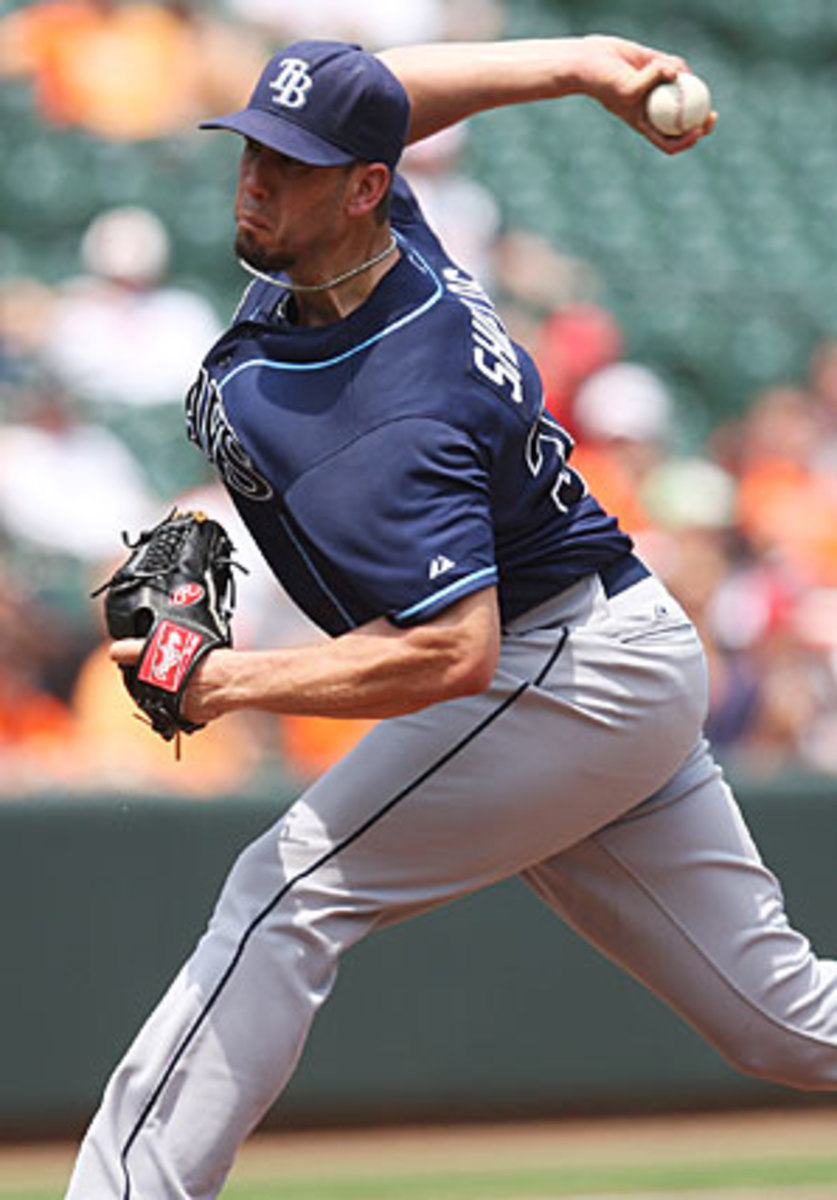Shields joins the market

James Shields got knocked around by the Orioles on Thursday to fall to 8-7 with a 4.52 ERA. (Cal Sport Media)

For weeks, Cole Hamels and Zack Greinke have topped the list of starting pitchers who might be available at the deadline, with Ryan Dempster and Matt Garza occupying the next tier down. The presence of those names on the list had everything to do with the likelihood that their respective teams would admit that 2012 isn't their year, something the Cubs embraced at the outset, but that the Phillies and Brewers have wavered on. Philadelphia, despite being 10 games below .500, took Hamels off the market on Wednesday when they announced they had signed him to a six-year, $144 million extension, while Milwaukee, nine games under .500 itself, has finally acknowledged that they're open for business, and the Marlins' recent moves have suggested that Josh Johnson could be acquired for the right price.
Perhaps more counterintuitive is the idea that the Rays would market James Shields as a possible frontline alternative to the names above. After all, they're three games above .500 at 51-48, and while they're a distant 8 1/2 games back in the AL East race, they're just 2 1/2 back in the Wild Card, with a +13 run differential. Even so, the Rays have reportedly let teams know that all of their starters except David Price and Matt Moore can be had, meaning not only Shields but 2011 AL Rookie of the Year Jeremy Hellickson, Wade Davis, Alex Cobb or Chris Archer. None of the last three would net huge hauls, but Shields and Hellickson both would. With Hamels now off the market, and Dempster in limbo after wavering on a trade to the Braves, teams such as the Angels, Rangers and Dodgers have turned their attention to the man who's been called "Big Game James."
At first glance, Shields appears to be a pitcher whose career has been rife with inconsistency; just check the year-to-year swings of his ERA: 4.84, 3.85, 3.56, 4.14, 5.18, 2.82, and now 4.52. Yet he has consistently combined excellent control (a career walk rate of 2.1 per nine) with the ability to miss bats (a career strikeout rate of 7.6 per nine) such that his strikeout-to-walk ratio has been at 3.2 or above in every season since his rookie year. Among pitchers with at least 1,000 innings since 2007, his 3.7 K/BB ratio ranks sixth, with the five guys above him — Roy Halladay, Cliff Lee, Dan Haren, Cole Hamels and Greinke — having combined for three Cy Young awards in that span. He's been durable, too, one of seven pitchers who has topped 200 innings in five straight seasons, again in the company of Cy Young winners Halladay, Justin Verlander and CC Sabathia.
Shields' inconsistency owes plenty to matters further beyond his control, namely hits on balls in play and home runs. His career BABIP is .305, six points higher than the AL average during that time, with swings from .344 (driving that 5.18 ERA in 2010) to .260 (with the 2.84 ERA in 2011) to .339 (accompanied by a 4.39 ERA this year) — all in the last three seasons. His career home run rate is on the high side at 1.2 per nine, ranging from a high of 1.5 (in 2010) to a low of 0.9 (in 2011); he's at 1.2 per nine this year despite a career-best 55 percent groundball rate; his rate of home runs per fly ball of 15.6 percent is well above the major league average. His Fielding Independent Pitching mark, an estimate of his ERA based upon his strikeout, walk, hit-by-pitch and home run rates, is 3.83 at the moment, while his xFIP, which uses his flyball rate and the league HR/FB rate instead of his home run rate, is an even lower 3.42. In other words, he's a better pitcher than his ERA suggests.
The Rangers, Angels and Dodgers are certainly among the teams that know this, and all have rotation needs to at least some extent. The Rangers just lost Colby Lewis for the season due to a torn flexor tendon, and Roy Oswalt is battling ongoing back woes. The Angels continue to watch Ervin Santana's ERA and home run rate soar; he's now at 6.00 and 1.9 per nine, respectively. The Dodgers are still without Ted Lilly, and they just traded his replacement, Nate Eovaldi, to Miami in the deal for Hanley Ramirez; they've been trying to obtain Dempster but won't surrender a prospect package of Chicago's liking, even with Dempster having suggested he prefers Los Angeles to Atlanta as far as his next destination goes.
What's attractive about Shields beyond his ability to miss bats is that he's cost-controlled. Back in January 2008, when he had less than two full major league seasons under his belt, he signed an incredibly team-friendly contract for four years and $11.25 million, with three more years of very affordable club options: $7 million for 2012, $9 million for 2013, and $12 million for 2014. As the pace of salary inflation has increased due to labor peace and increased television revenue, that contract is more appealing, not only to the budget-conscious Rays but to many other teams. If Tampa Bay does decide to trade him, it can net a significantly greater haul than the Cubs could for the pending free agent Dempster, or for Garza, who has one more year of arbitration eligibility beyond this season. For a team reluctant to cash in its blue chip prospects for a two-month rental, he makes a whole lot of sense.
B.J. Upton
Carlos Pena
